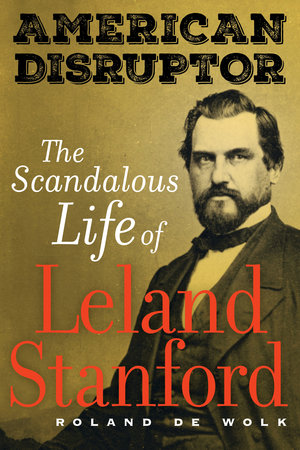Excerpted from American Disruptor: The Scandalous Life of Leland Stanford by Roland De Wolk
The origins of the Stanford campus and the Silicon Valley it has incubated, borne, and sustained could not have had a more unlikely birthplace: a frontier bar called the Bull’s Head tavern in the backwoods of upper New York state. The foundational person who began life there is known today as Leland Stanford, although as with so much of what is known of him, that is only nominally and partially true.
Leland Stanford’s singular story is that of a largely misunderstood and forgotten man, born in Jeffersonian America, when California seemed as distant as Saturn and when being able to read was less common than dying of tuberculosis or typhoid. The cotton gin was for early adopters in the primary business of America, farming. No one had yet even heard of a “tractor.”
When Leland Stanford was done with his work, his dominion had only begun. California was dressed and ready to become the leading economic, political, and cultural force of the nation. The world’s economies were unknowingly headed for silicon switches the size of molecules that would serenely glide them into a post-industrial revolution. And the way virtually every man, woman, and child in the world would live was altered permanently. All because of Leland Stanford’s astonishing, scandalous life.
* * *
Despite a rough beginning, a feckless youth, and a checkered manhood, Leland Stanford became the head of the nation’s biggest, most ambitious enterprise in America’s young history, requiring a ferocious persistence that daunted almost everyone around him. It provided him authoritative agency, allowing Stanford to amass multiple millions of dollars, employ thousands of workers, and create one of the first and most-bitterly hated monopolies in U.S. history, outstripping America’s more celebrated robber barons.
Stanford’s ceaseless quest for political power met with crushing defeat time and again but finally and fortuitously allowed him to fall into high office with a critical left-handed assist from Abraham Lincoln. Leland Stanford then, in an extraordinary but largely overlooked set of actions, fully exploited the position to get what today would be billions of taxpayer dollars to make fortunes for himself and his notorious small band of business partners. By the time he was in his 30s, Stanford was living more ostentatiously than maharajas, building overwrought mansions, and acquiring vast tracts of land.
Not long afterwards, however, the first of several government investigations commenced, prompting scandalous revelations of swindling the American people. Still, history also shows the business he pioneered not only was the foundation for the Silicon Valley, but for the modern corporation itself. What’s more, his company incited what was among the first historic government attempts to regulate what soon became known at the combines, trusts, and monopolies, establishing precedents years before the more popularly known sanctions against Standard Oil or U.S. Steel. In fact, neither Rockefeller nor Carnegie would be household names today if not for the rail system Stanford was, in great part, responsible for. And even beyond that, Stanford’s enterprise was largely what prompted a technology governing much of everyday life: the method by which almost everyone uses a clock around the world—the creation of universal time zones.
With his sybaritic life at an apex, the central calamity of his existence took place while on a grand tour of European art galleries and luxury resorts: his beloved 15-year-old son—an only child sired after 18 years of barren marriage—died suddenly while Stanford and his wife sat helplessly by the boy’s bedside, attended by the most expensive doctors on the Continent.
But Stanford had one last card to play. He and his under-estimated wife, Jennie, created an extravagant memorial to the overwhelming heartbreak: Leland Stanford Junior University. Then the school, too, floundered, despite beginning with what appeared to be the single largest endowment of any university in American history. In fact, the entire enterprise teetered, almost failing and folding not long after its founding. When Leland Stanford, Sr. died, leaving the university on the brink of closing, an examination of his personal estate found he had passed away just in time to avoid the indignity of bankruptcy.
He left his widow to fight the power of the United States government, which took her to the Supreme Court, charging Stanford with owing his fortune to the American public. With practical determination only a few had glimpsed beforehand, Jennie braced herself and found strength to turn the shipwreck into salvation. Then she died horrendously on a Hawaiian island. An in-depth, official medical inquest determined it was murder. A subsequent, sketchy probe paid by the university administration did not. A modern investigation by no less than a Stanford University professor of medicine confirmed the homicide finding. Today there is clear evidence of a cover-up by the first, often revered, president of Stanford University.

